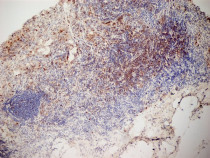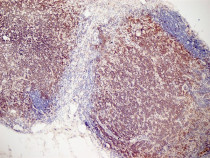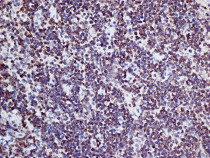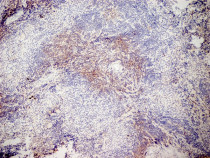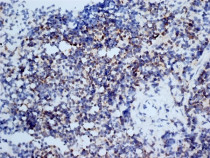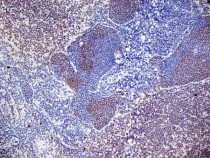ARG23049
anti-CD3 antibody [KT3]
anti-CD3 antibody [KT3] for Flow cytometry,IHC-Frozen sections and Mouse
Overview
| Product Description | Rat Monoclonal antibody [KT3] recognizes CD3 CD3 antibody, clone KT3 recognizes the mouse CD3 antigen expressed by mature T cells. Clone KT3 may be used to trigger proliferation and cytotoxicity of CD3 positive cells. |
|---|---|
| Tested Reactivity | Ms |
| Tested Application | FACS, IHC-Fr |
| Host | Rat |
| Clonality | Monoclonal |
| Clone | KT3 |
| Isotype | IgG2a |
| Target Name | CD3 |
| Antigen Species | Mouse |
| Immunogen | CBAT6 thymocytes. |
| Conjugation | Un-conjugated |
Application Instructions
| Application Suggestion |
|
||||||
|---|---|---|---|---|---|---|---|
| Application Note | IHC-Fr: The epitope recognised by this antibody is reported to be sensitive to formaldehyde fixation and tissue processing. Arigo recommends the use of acetone fixation for frozen sections. FACS: Use 10 µl of the suggested working dilution to label 10^6 cells in 100 µl. * The dilutions indicate recommended starting dilutions and the optimal dilutions or concentrations should be determined by the scientist. |
Properties
| Form | Liquid |
|---|---|
| Purification | Purification with Protein G. |
| Buffer | PBS and 0.09% Sodium azide |
| Preservative | 0.09% Sodium azide |
| Concentration | 1 mg/ml |
| Storage Instruction | For continuous use, store undiluted antibody at 2-8°C for up to a week. For long-term storage, aliquot and store at -20°C or below. Storage in frost free freezers is not recommended. Avoid repeated freeze/thaw cycles. Suggest spin the vial prior to opening. The antibody solution should be gently mixed before use. |
| Note | For laboratory research only, not for drug, diagnostic or other use. |
Bioinformation
| Gene Symbol | CD3D, CD3E, CD3G, CD247 |
|---|---|
| Gene Full Name | CD3 Delta Subunit Of T-Cell Receptor Complex, CD3 Epsilon Subunit Of T-Cell Receptor Complex, CD3 Gamma Subunit Of T-Cell Receptor Complex, CD247 Molecule |
| Background | CD3 (cluster of differentiation 3) is a protein complex and T cell co-receptor that is involved in activating both the cytotoxic T cell (CD8+ naive T cells) and T helper cells (CD4+ naive T cells). It is composed of four distinct chains. In mammals, the complex contains a CD3γ chain, a CD3δ chain, and two CD3ε chains. These chains associate with the T-cell receptor (TCR) and the CD3-zeta (ζ-chain) to generate an activation signal in T lymphocytes. The TCR, CD3-zeta, and the other CD3 molecules together constitute the TCR complex. |
| Highlight | Related products: CD3 antibodies; CD3 ELISA Kits; CD3 Duos / Panels; CD3 recombinant proteins; Anti-Rat IgG secondary antibodies; Related news: New antibody panels and duos for Tumor immune microenvironment Tumor-Infiltrating Lymphocytes (TILs) Exploring Antiviral Immune Response |
| Calculated MW | 20 kDa |
Images (6) Click the Picture to Zoom In
-
ARG23049 anti-CD3 antibody [KT3] IHC-Fr image
Immunohistochemistry: Mouse lymph node cryosection stained with ARG23049 anti-CD3 antibody [KT3] followed by HRP-conjugated Goat anti Rat IgG as a detection reagent. (Low power).
-
ARG23049 anti-CD3 antibody [KT3] IHC-Fr image
Immunohistochemistry: Mouse lymph node cryosection stained with ARG23049 anti-CD3 antibody [KT3] followed by HRP-conjugated Goat anti Rat IgG as a detection reagent. (Low power).
-
ARG23049 anti-CD3 antibody [KT3] IHC-Fr image
Immunohistochemistry: Mouse lymph node cryosection stained with ARG23049 anti-CD3 antibody [KT3] followed by HRP-conjugated Goat anti Rat IgG as a detection reagent. (High power).
-
ARG23049 anti-CD3 antibody [KT3] IHC-Fr image
Immunohistochemistry: Mouse spleen cryosection stained with ARG23049 anti-CD3 antibody [KT3] followed by HRP-conjugated Goat anti Rat IgG as a detection reagent. (Low power).
-
ARG23049 anti-CD3 antibody [KT3] IHC-Fr image
Immunohistochemistry: Mouse spleen cryosection stained with ARG23049 anti-CD3 antibody [KT3] followed by HRP-conjugated Goat anti Rat IgG as a detection reagent. (Medium power).
-
ARG23049 anti-CD3 antibody [KT3] IHC-Fr image
Immunohistochemistry: Mouse lymph node cryosection stained with ARG23049 anti-CD3 antibody [KT3] followed by HRP-conjugated Goat anti Rat IgG as a detection reagent. (Low power).
